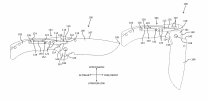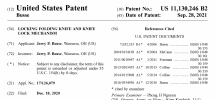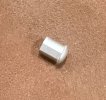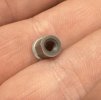Jerry Busse
Moderator
- Joined
- Aug 20, 1999
- Messages
- 12,080
Ground Troop 35 (GT35) Design Discussion
Lots of questions have been pouring in about the BLOCK lock and other design features of the GT35.
Feel free to ask questions, and I'll do my best to answer as many as possible.
Here are a few discussion points to get us started.
The GT35 is a remarkable folder. The handle is EXTREMELY thin at only 1/4" (.250).
Combine this with an overall weight of approximately 2.8 ounces, and it is ridiculously thin and light.
I have been carrying one in my shirt pocket for over a year now, and I have to feel my pocket to see if it is in there!!!
If you've been looking for your favorite EDC Folder, this is the way to go!
Our goal with the GT35 was to make the strongest, lightweight, and stain-resistant folder ever built.
I believe that we have achieved that goal.
In our lock-strength tests, nothing in this size range has even come close so far.
The GT35 was designed for the battlefield, where every ounce counts and toughness, ease of resharpening, and stain resistance are of utmost importance.
When used on AEB-L, our deep cryogenic, INFI-type heat treat protocol has yielded very impressive results thus far.
The finely ground blade is easy to keep sharp in the field without having to completely re-grind it.
The steel choice is important in this design, as it plays a major role in the strength of the lock.
BC AEB-L has proven to be up to the task at hand.
Why no talon hole? Putting a "talon hole" in the handle could put your lock mechanism at risk, depending on location and size.
Most importantly, however, is understanding that our Trademarked talon hole is specifically noted to be in the rearward portion of the "Blade" and not in the handle itself.
The main difference between our BLOCK lock and a crossbar lock is that our locking block rests on the spine of the knife as opposed to spanning both handle slabs, like most other crossbar locks.
Our thumb button release on the side of the GT35 will be shorter and of a lower profile than the one pictured by nearly .040"
The CNC-machined solid billet of 6AL4V offers much higher strength than typical "panel" folders because the handles are not dependent on micro-screws for strength and rigidity.
Why is it called the BLOCK lock? Once you see the inner workings of this folder, you will quickly note that a large block of hardened stainless steel (58-60 RC) is moved forward by a compression spring, not an omega spring, to ensure the proper seating of the lock block.
We are having custom ball bearings made for this model and will post pics once they are available.
Someone mentioned the "Double click" sound of the BLOCK lock. It reminds me of the beautiful sound made by the original Colt Single Actions of years gone by.
You can eliminate the sound by holding the lock button back during deployment. But, if you're like me, you will fall in love with the sound of this bank vault-like engagement!
Let's Drink!
Jerry
.
Lots of questions have been pouring in about the BLOCK lock and other design features of the GT35.
Feel free to ask questions, and I'll do my best to answer as many as possible.
Here are a few discussion points to get us started.
The GT35 is a remarkable folder. The handle is EXTREMELY thin at only 1/4" (.250).
Combine this with an overall weight of approximately 2.8 ounces, and it is ridiculously thin and light.
I have been carrying one in my shirt pocket for over a year now, and I have to feel my pocket to see if it is in there!!!
If you've been looking for your favorite EDC Folder, this is the way to go!
Our goal with the GT35 was to make the strongest, lightweight, and stain-resistant folder ever built.
I believe that we have achieved that goal.
In our lock-strength tests, nothing in this size range has even come close so far.
The GT35 was designed for the battlefield, where every ounce counts and toughness, ease of resharpening, and stain resistance are of utmost importance.
When used on AEB-L, our deep cryogenic, INFI-type heat treat protocol has yielded very impressive results thus far.
The finely ground blade is easy to keep sharp in the field without having to completely re-grind it.
The steel choice is important in this design, as it plays a major role in the strength of the lock.
BC AEB-L has proven to be up to the task at hand.
Why no talon hole? Putting a "talon hole" in the handle could put your lock mechanism at risk, depending on location and size.
Most importantly, however, is understanding that our Trademarked talon hole is specifically noted to be in the rearward portion of the "Blade" and not in the handle itself.
The main difference between our BLOCK lock and a crossbar lock is that our locking block rests on the spine of the knife as opposed to spanning both handle slabs, like most other crossbar locks.
Our thumb button release on the side of the GT35 will be shorter and of a lower profile than the one pictured by nearly .040"
The CNC-machined solid billet of 6AL4V offers much higher strength than typical "panel" folders because the handles are not dependent on micro-screws for strength and rigidity.
Why is it called the BLOCK lock? Once you see the inner workings of this folder, you will quickly note that a large block of hardened stainless steel (58-60 RC) is moved forward by a compression spring, not an omega spring, to ensure the proper seating of the lock block.
We are having custom ball bearings made for this model and will post pics once they are available.
Someone mentioned the "Double click" sound of the BLOCK lock. It reminds me of the beautiful sound made by the original Colt Single Actions of years gone by.
You can eliminate the sound by holding the lock button back during deployment. But, if you're like me, you will fall in love with the sound of this bank vault-like engagement!
Let's Drink!
Jerry
.






